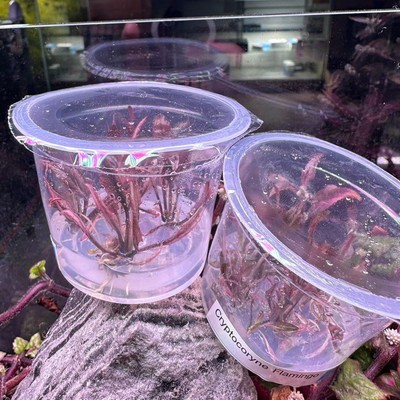Cryptocoryne Pink Flamingo: A Detailed Guide to Care and Cultivation
Posted by Max Gandara on on 29th Feb 2024
Physical Characteristics:
Cryptocoryne Pink Flamingo is renowned for its striking pink leaves, a feature that sets it apart from other Cryptocoryne species. The elongated, lance-shaped leaves can exhibit various shades of pink, from soft pastels to deeper hues, depending on environmental factors and individual plant health. The leaves may have a slightly transparent quality, adding to the overall visual appeal.
This Cryptocoryne typically grows to a height of 6 to 10 inches (15 to 25 centimeters), making it suitable for mid to background placement in aquariums. As the plant matures, it may develop a bushy appearance with multiple leaves emerging from a central root system.
Optimal Conditions for Growth:
To ensure the healthy growth of Cryptocoryne Pink Flamingo, it's essential to replicate its natural habitat conditions. Here are the optimal parameters for cultivating this striking aquatic plant:
- Lighting: Provide moderate to high lighting conditions. Cryptocoryne Pink Flamingo can thrive in low light, but higher light levels often enhance its vibrant pink coloration and promote robust growth.
- Temperature: Maintain a temperature range of 72°F to 82°F (22°C to 28°C). This temperature range aligns with the tropical conditions of its native habitats.
- pH Level: Keep the pH level in the range of 6.0 to 7.5. Cryptocoryne plants generally prefer slightly acidic to neutral water.
- Substrate: Use a nutrient-rich substrate to support the plant's root system. Cryptocoryne Pink Flamingo benefits from a substrate that provides essential nutrients for healthy growth.
- CO2 Injection: While not mandatory, supplementing with CO2 can enhance growth and intensify the pink coloration of the leaves. However, Cryptocoryne Pink Flamingo can still thrive without CO2 injection.
Care Requirements:
- Substrate: Plant Cryptocoryne Pink Flamingo in a nutrient-rich substrate to promote root development. A substrate specifically designed for aquarium plants is recommended.
- Moderate Water Flow: Cryptocoryne species generally prefer moderate water flow. High currents may damage the delicate leaves of Cryptocoryne Pink Flamingo, so ensure a gentle water flow in the aquarium.
- Fertilization: Cryptocoryne Pink Flamingo benefits from regular fertilization. Use a comprehensive liquid fertilizer or root tabs to supply essential nutrients like iron, potassium, and trace elements.
- Regular Pruning: Trim any damaged or decaying leaves regularly to encourage new growth and maintain the plant's aesthetic appeal.
Propagation Techniques:
Cryptocoryne Pink Flamingo can be propagated through division, a common method for Cryptocoryne species. Follow these steps for successful propagation:
- Separate Rhizomes: Gently uproot the plant and locate the rhizomes, which are horizontal stems that produce roots and shoots. Using clean scissors or plant scissors, carefully separate the rhizomes into individual sections.
- Plant Separated Sections: Plant each separated section with its roots into the substrate, ensuring that the rhizome is partially buried. This encourages the development of new shoots and roots.
- Provide Adequate Care: Newly separated sections may experience a period of adjustment. Maintain stable environmental conditions, and the propagated sections should start growing independently.
Challenges and Considerations:
While Cryptocoryne Pink Flamingo is generally hardy, there are a few challenges to be aware of:
- Melt Period: Cryptocoryne plants often experience a melt period when introduced to new aquariums or conditions. During this phase, the plant may shed its existing leaves but will typically regrow healthier foliage.
- Algae Issues: Like many aquarium plants, Cryptocoryne Pink Flamingo is susceptible to algae growth. Ensure a balance of light, nutrients, and carbon dioxide to prevent excessive algae.
- Planting Depth: Avoid planting the Cryptocoryne too deep in the substrate, as this can lead to issues such as rhizome rot. The rhizome should be partially buried but not completely covered.
Cryptocoryne Pink Flamingo adds a delightful burst of color and elegance to freshwater aquariums. With its striking pink leaves and manageable care requirements, it appeals to both beginner and experienced aquarists.

